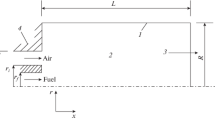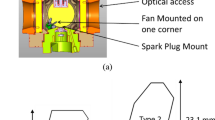Abstract
The effects of the number of heat exchanger modules on thermal characteristics were experimentally studied in a premixed combustion system with a cross-flow staggered-tube heat exchanger. The various heat exchanger modules, from 4 to 8, combined with a premixed burner were tested to investigate the performance of the heat exchanger through the surface area of the heat exchanger at various equivalence ratios. Additionally, the performance of the heat exchanger was analyzed by applying entropy generation theory to the heat exchanger system. As a result, although the heat transfer rate increases with the increase of the equivalence ratio, the NOx and CO concentrations also increase due to the increasing flame temperature. In addition, the entropy generation increases with an increase of the equivalence ratio. Furthermore, the heat transfer rate and the effectiveness are increased with the increase of the number of the heat exchanger modules. Also, the effectiveness is sharply increased when the number of the heat exchanger modules is increased from 4 to 5. Consequently, the optimal operating conditions regarding pollutant emission, effectiveness and entropy generation in this experimental range are 0.85 for the equivalence ratio and 8 for the number of heat exchanger modules.
Similar content being viewed by others
References
J. Y. Kim and T. H. Song, Effect of tube alignment on the heat/mass transfer from a plate fin and two-tube assembly: naphthalene sublimation results, Int. J. Heat Mass Transf., 46 (2003) 3051–3059.
J. Dong, L. Su, Q. Chen and W. Xu, Experimental study on thermal-hydraulic performance of a wavy fin-and-flat tube aluminum heat exchanger, Appl. Therm. Eng., 51 (2013) 32–39.
J. S. Leu, Y. H. Wu and J. Y. Jang, Heat transfer and fluid flow analysis in plate-fin and tube heat exchangers with a pair of block shape vortex generators, Int. J. Heat Mass Transf., 47 (2004) 4327–4338.
P. Paulraj, B. K. Paul and R. B. Peterson, Development of an adhesive-bonded counterflow microchannel heat exchanger, Appl. Therm. Eng., 48 (2012) 194–201.
T. Dang and J. T. Teng, The effects of configurations on the performance of microchannel counter-flow heat exchangers-An experimental study, Appl. Therm. Eng., 31 (2011) 3946–3955.
N. Garcia-Hernando, A. Acosta-Iborra, U. Ruiz-Rivas and M. Izquierdo, Experimental investigation of fluid flow and heat transfer in a single-phase liquid flow micro-heat exchanger, Int. J. Heat Mass Transf., 52 (sn23-24) (2009) 5433–5446.
M. I. Hasan, A. A. Rageb, M. Yaghoubi and H. Homayoni, Influence of channel geometry on the performance of a counter flow microchannel heat exchanger, Int. J. Therm. Sci., 48 (8) (2009) 1607–1618.
M. N. Pantzali, A. A Mouza and S. V. Paras, Investigating the efficacy of nanofluids as coolants in plate heat exchangers (PHE), Chem. Eng. Sci., 64 (14) (2009) 3290–3300.
J. M. Kim, J. Park, S. Lee, C. E. Lee and S. M. Kum, Characteristics of Thermal Efficiency with Changing Distances Between Tubes for Heat Exchanger, Journal of Energy Engineering, 19 (3) (2010) 177–181.
E. S. Cho, C. K. Park and K. S. Choi, A study on the combustion characteristics of flat-plate premixed burner for various flame surface media and heat exchangers, Journal of KSME B, 35 (10) (2011) 1033–1040.
B. Yu, S. M. Kum, C. E. Lee and S. Lee, An experimental study of heat transfer and pollutant emission characteristics at varying distances between the burner and the heat exchanger in a compact combustion system, Energy, 42 (1) (2012) 350–357.
A. Gupta and S. K. Das, Second law analysis of crossflow heat exchanger in the presence of axial dispersion in one fluid, Energy, 32 (5) (2007) 664–672.
P. Minutolo, A. D’Anna, M. Commodo, R. Pagliara, G. Toniato and C. Accordini, Emission of ultrafine particles from natural gas Domestic Burners, Environ. Eng. Sci., 25 (10) (2008) 1357–1364.
S. Lee, S. M. Kum and C. E. Lee, Performances of a heat exchanger and pilot boiler for the development of a condensing gas boiler, Energy, 36 (7) (2011) 3945–3951.
S. J. Kline and F. A. McKlintock, Describing uncertainty in single sample experiments, Mech. Eng., 75 (1953) 3–8.
A. Bejan, Entropy generation through heat transfer and fluid flow, Wiley, New York, USA (1982).
D. Poulikakos and A. Bejan, Fin geometry for minimum entropy generation in forced convection, J. Heat Transf. -Trans. ASME, 104 (1982) 616–623.
P. Napon, Study on the exergy loss of the horizontal concentric micro-fin tube heat exchanger, Int. Communications in Heat and Mass transfer, 38 (2011) 229–235.
E. D. Grimison, Correlation and utilization of new data on flow resistance and heat transfer for cross flow of gases over tube banks, Trans. ASME, 59 (1937) 583–594.
F. P. Incropera and D. P. Dewitt, Fundamentals of Heat and Mass Transfer, 4th ed., John Wiley&Sons, Inc., New York, USA (1996).
A. Zukauskas, Heat transfer from tubes in crossflow -Advances in heat transfer (18), Academic Press, New York, USA (1972).
S. R. Turns, An introduction to combustion: concepts and applications, 3rd ed., McGraw-Hill, Singapore, Singapore (2012).
Korean Agency for Technology and Standards, KS B 8127-Condensing gas burning hot water boiler (2010).
R. Kemna, M. V. Elburg, W. Li and R. V. Holsteijn, Preparatory study on eco-design of CH-boilers, VHK, Brussels, Belgium (2007).
Author information
Authors and Affiliations
Corresponding author
Additional information
Byeonghun Yu received his B.S. and M.S. degrees in Mechanical Engineering from Inha University, Korea in 2001 and 2003, respectively. He received a Ph.D. degree from Inha University, Korea in 2013. Dr. Yu is a post-doctoral researcher at Regional Innovation Center for Automobile Powertrains in Inha University. His research interests are in the area of high efficiency and low emission technologies for gas combustion system.
Sung-Min Kum received a Ph.D. degree in Mechanical Engineering from Inha University, Korea in 1994. Dr. Kum is currently a professor at the School of Mechanical and Automotive Engineering in Halla University, Korea. His research interests are in the heat transfer enhancement in impinging air jet, turbulence promotor and heat exchangers.
Chang-Eon Lee received his B.S. and M.S. degrees in Mechanical Engineering from Inha University, Korea in 1983 and 1985, respectively. He received a Ph.D. degree from Toyohashi National University of Technology, Japan in 1992. Dr. Lee is a professor at the department of Mechanical Engineering in Inha University, Korea and a director of Regional Innovation Center for Automobile Powertrains. He is currently on the president of the Korean Society of Combustion. His research interests are in the area of gas combustion system and internal engine.
Seungro Lee received his B.S. and M.S. degrees in Mechanical Engineering from Inha University, Korea in 1998 and 2000, respectively. He then received his Ph. D. degree from University of Southern California, USA in 2008. He is currently an Assistant professor at the Department of Mechanical Engineering in Chonbuk National University, Korea. His research interests are in the area of high efficiency and low emission combustion system, alternative fuels and flow visualization.
Rights and permissions
About this article
Cite this article
Yu, B., Kum, SM., Lee, CE. et al. Experimental study on the effects of the number of heat exchanger modules on thermal characteristics in a premixed combustion system. J Mech Sci Technol 30, 447–456 (2016). https://doi.org/10.1007/s12206-015-1249-9
Received:
Revised:
Accepted:
Published:
Issue Date:
DOI: https://doi.org/10.1007/s12206-015-1249-9




